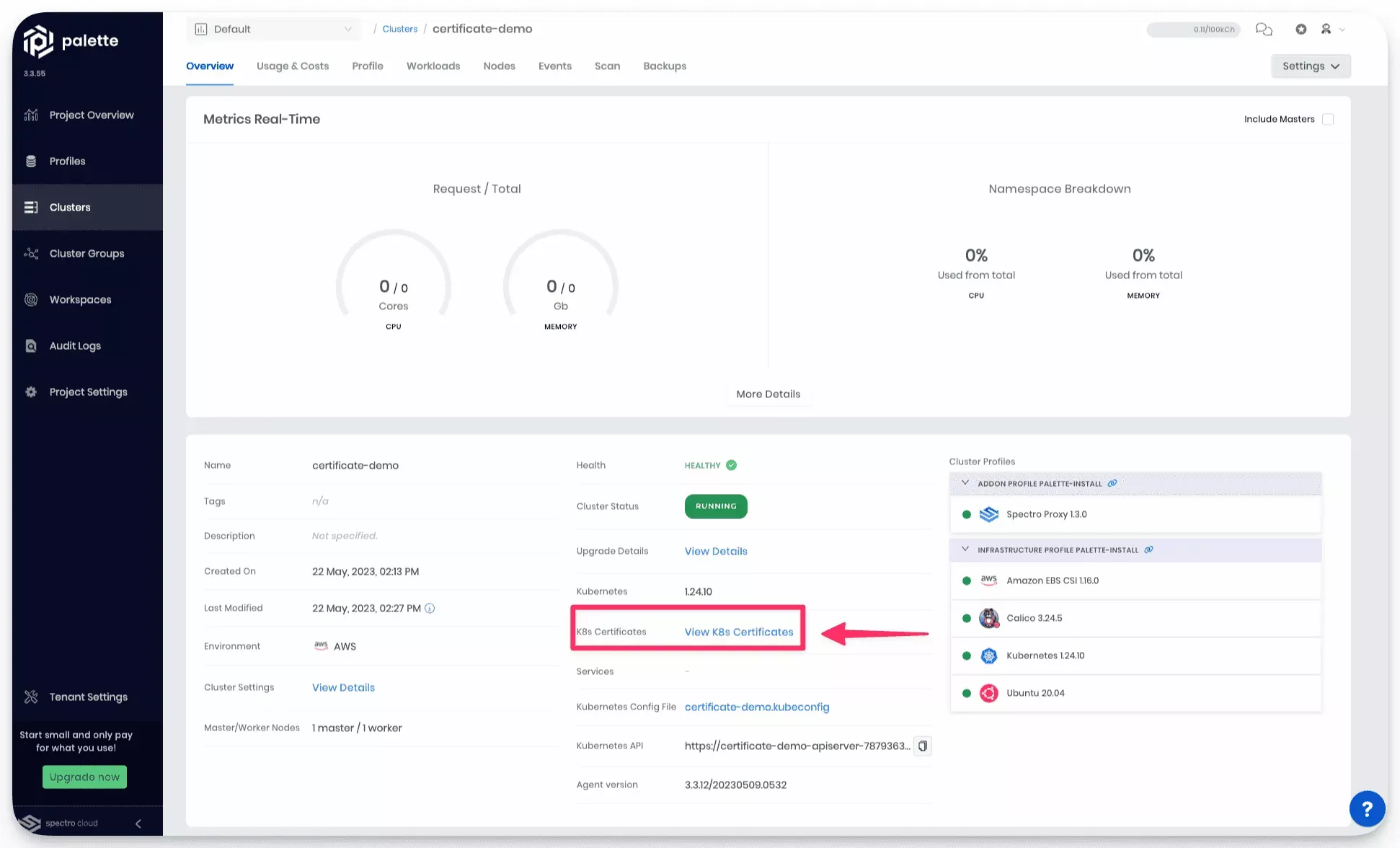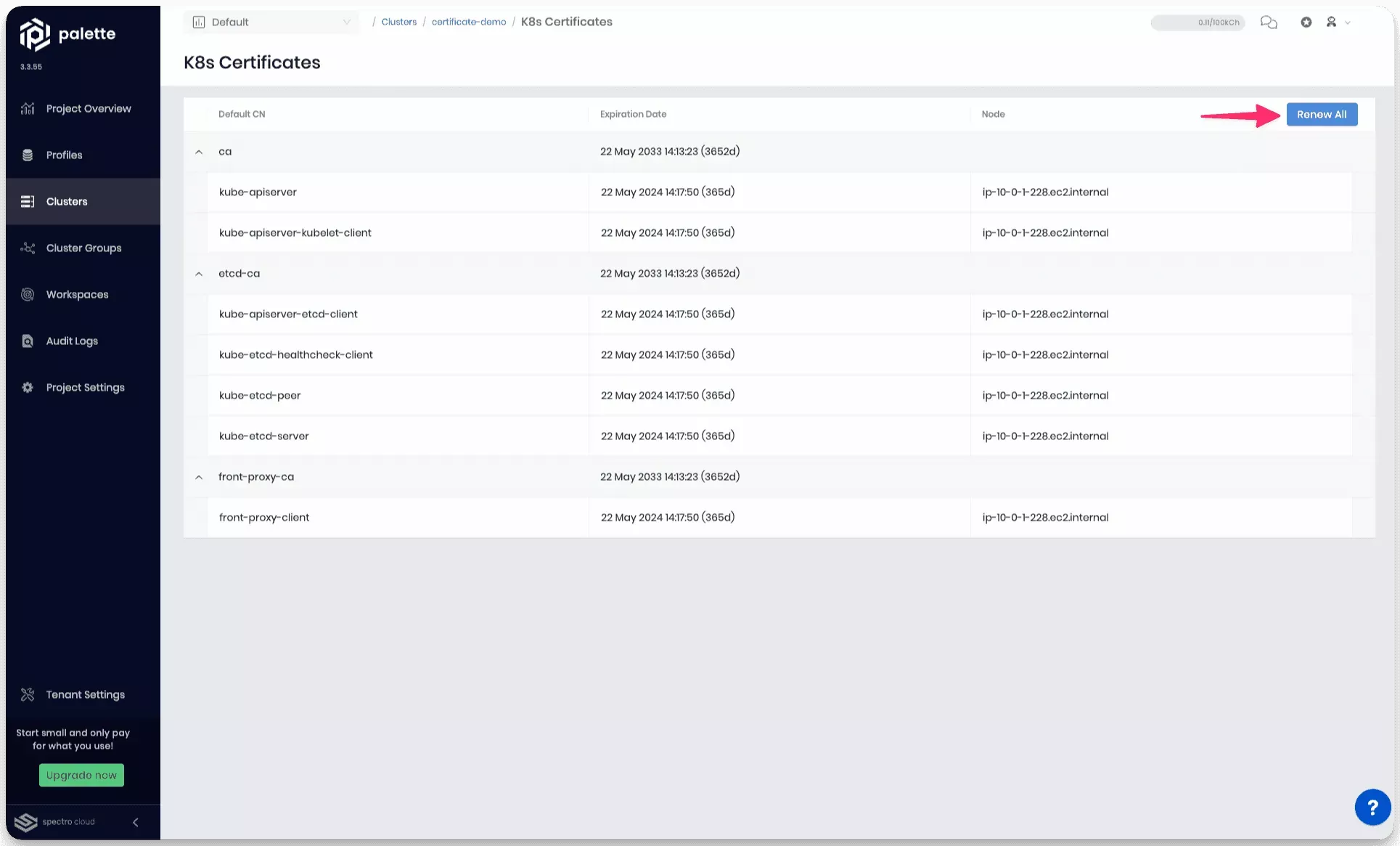Renew Cluster PKI Certificates
In Kubernetes, Public Key Infrastructure (PKI) certificates are used to secure communications and authenticate components within the cluster. Certificates have an expiry date and need to be renewed periodically. You can view the issue and expiry date of the cluster by click on View K8s Certificates in the cluster details page.
This page focuses on how to renew the PKI certificates through Palette. You have two options for how you can renew the cluster PKI certificates:
Certificates created by kubeadm expire after 365 days. The Root Certificate Authority (CA) is valid for 3652 days or 10 years.
Certificate Renewal Impact on Cluster Availability
After the new certificates are generated, the cluster needs to restart the control plane components in order to pick up the new certificates. Depending on your cluster structure, this restart period may impact the cluster management availability of your cluster, but will not affect your cluster workloads:
- If you have a single-node control plane, this will cause a short period of downtime for the control plane components, meaning that cluster management availability will be temporarily impacted. However, your worker nodes will continue to operate normally in the meantime and their workloads will not be impacted.
- If you have three nodes or more in your control plane, certificate renewal will not cause downtime for neither the control plane components nor worker nodes.
Limitations
-
Both automatic and manual certificate renewal will renew control plane certificates only. Worker node certificate renewal is not supported.
-
Airgapped Edge clusters are not managed by Palette. To renew the certificates for airgapped Edge clusters, refer to Renew Certificates for Airgap Clusters.
Automatic Certificate Renewal
Palette will automatically update the cluster PKI certificates 30 days before they expire. You can view the issue and expiry date of the cluster by clicking on View K8s Certificates in the cluster details page.
Another scenario that results in new PKI certificates is upgrading a cluster's Kubernetes version. Upgrading a cluster's Kubernetes version, whether a minor patch or a major release, results in renewed PKI certificates. We recommend regularly updating your clusters to stay current with security fixes and best practices.
You can upgrade the Kubernetes version of a cluster by updating the Kubernetes layer of the cluster profile and applying the cluster profile update to the cluster. For guidelines on updating pack versions, review Update the Pack Version.
Manual Certificate Renewal
You can renew the cluster PKI certificates on-demand using the Palette API or the Palette User Interface (UI). Palette uses the same process to renew the cluster PKI certificates as the automatic renewal process. The only difference is that the manual renewal is triggered by the user.
Review the following sections to learn how to manually renew the cluster PKI certificates. Choose your preferred update method, using the Palette UI or the API.
Prerequisites
- UI
- API
-
A deployed host cluster.
-
Access to the host cluster.
-
A Palette API key. You can learn how to create a Palette API key by reviewing the API Key documentation.
-
A deployed host cluster.
-
Access to the host cluster.
Renew Cluster Certificate
- UI
- API
-
Log in to Palette.
-
Navigate to the left Main Menu and select Clusters.
-
Select the host cluster to renew its PKI certificates.
-
From the cluster details page, click on View K8s Certificates.

- Next, select Renew All to start the renewal process.

The renewal process may take several minutes, depending on the number of cluster nodes.
-
Set your Palette API key as an environment variable. Add your actual API key in place of
REPLACE_ME.export API_KEY=REPLACE_ME -
Set the project ID as an environment variable. Add your project ID in place of
REPLACE_ME. You can find the project ID on the Palette landing page. The project ID is displayed in the top right corner of the page.export PROJECT_ID=REPLACE_ME -
Set the cluster ID as an environment variable. Add your cluster's ID in place of
REPLACE_ME. You can get the cluster ID from the cluster detail's page URL. The value afterclusters/is the cluster ID.export CLUSTER_ID=REPLACE_ME -
Use the Palette API endpoint
https://api.spectrocloud.com/v1/spectroclusters/{uid}/k8certificates/renewto renew a cluster's PKI certificates. The endpoint accepts the HTTP methodPATCH, and the only required parameter is the cluster ID.curl --request PATCH \
--url 'https://api.spectrocloud.com/v1/spectroclusters/$CLUSTER_ID/k8certificates/renew' \
--header 'Content-Type: application/json' \
--header 'Accept: application/json' \
--header "ApiKey: $API_KEY" \
--header "ProjectUid: $PROJECT_ID" -
No output is returned and an HTTP status
204is expected.
The renewal process may take several minutes, depending on the number of cluster nodes.
Validate
- UI
- API
Using the following steps, you can validate that the cluster's PKI certificates were renewed.
-
Log in to Palette.
-
Navigate to the left Main Menu and select Clusters.
-
Select the host cluster with the renewed PKI certificates.
-
From the cluster details page, click on View K8s Certificates.
-
Review the expiration date for each component. Each component's expiration date will have a status of 365d with a date that is one year away.
Using the following steps, you can validate that the cluster's PKI certificates were renewed.
-
Set your Palette API key as an environment variable. Add your actual API key in place of
REPLACE_ME.export API_KEY=REPLACE_ME -
Set the project ID as an environment variable. Add your project ID in place of
REPLACE_ME.export PROJECT_ID=REPLACE_ME -
Set the cluster ID as an environment variable. Add your cluster's ID in place of
REPLACE_ME.export CLUSTER_ID=REPLACE_ME -
Retrieve the cluster's certificate information from Palette by using the
https://api.spectrocloud.com/v1/spectroclusters/{uid}/k8certificatesendpoint.curl \
--url 'https://api.spectrocloud.com/v1/spectroclusters/$CLUSTER_ID/k8certificates' \
--header 'Content-Type: application/json' \
--header 'Accept: application/json' \
--header "ApiKey: $API_KEY" \
--header "ProjectUid: $PROJECT_ID" -
Validate the output and confirm the expiration date is one year away.
{
"machineCertificates": [
{
"certificateAuthorities": [
{
"certificates": [
{
"expiry": "2024-05-23T16:51:05.000Z",
"name": "front-proxy-client"
}
],
"expiry": "2033-05-23T16:45:22.209Z",
"name": "front-proxy-ca"
},
{
"certificates": [
{
"expiry": "2024-05-23T16:51:05.000Z",
"name": "kube-apiserver"
},
{
"expiry": "2024-05-23T16:51:05.000Z",
"name": "kube-apiserver-kubelet-client"
}
],
"expiry": "2033-05-23T16:45:22.209Z",
"name": "ca"
},
{
"certificates": [
{
"expiry": "2024-05-23T16:51:05.000Z",
"name": "kube-apiserver-etcd-client"
},
{
"expiry": "2024-05-23T16:51:05.000Z",
"name": "kube-etcd-healthcheck-client"
},
{
"expiry": "2024-05-23T16:51:05.000Z",
"name": "kube-etcd-peer"
},
{
"expiry": "2024-05-23T16:51:05.000Z",
"name": "kube-etcd-server"
}
],
"expiry": "2033-05-23T16:45:22.209Z",
"name": "etcd-ca"
}
],
"name": "ip-10-0-1-120.ec2.internal"
}
]
}